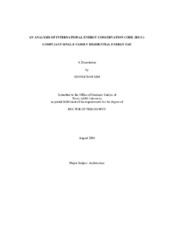| dc.description.abstract | In 2001, the Texas State Senate passed Senate Bill 5 to reduce ozone levels by encouraging
the reduction of emissions of NOx that were not regulated by the Texas Natural Resource
Conservation Commission, including point sources (power plants), area sources (such as residential
emissions), road mobile sources, and non-road mobile sources. For the building energy section, the
Texas State Legislature adopted the 2000/2001 International Energy Conservation Code, as
modified by the 2001 Supplement, as the state's building energy code. The 2000/2001 IECC is a
comprehensive energy conservation code that establishes a standard for the insulation levels,
glazing and cooling and heating system efficiencies through the use of prescriptive and
performance-based provisions.
Therefore, the purpose of this research is to improve the accuracy of a 2000/2001 IECCcompliant
performance simulation using the DOE-2.1e simulation program to investigate the energy
performance of a typical single-family house. To achieve this purpose, several objectives had to be
accomplished, including: 1) the development of an IECC-compliant simulation model, 2) the
development and testing of specific improvements to the existing code-traceable model, 3) the
calibration and installation of sensors in a case-study house, 4) the validation of the improved simulation model with measured data from the case-study house, and 5) use the validated model to
simulate the energy-conserving features of single-family residences that cannot be simulated with
existing versions of the DOE-2.1e program.
In order to create the code-traceable IECC-compliant simulation model, a base-case house
simulation was created and the results calibrated with measured energy and environmental data
from the case-study house. This was done in order to obtain an improved simulation model that
would more accurately represent the case-study building. The calibrated model was then used to
verify the accuracy of the improved simulation methods against previous models and measured data.
After validation of the new simulation methodologies, the IECC simulation model was used
to simulate different energy-conserving features for a single-family residence that could not be
simulated with the previous version of the DOE-2 input file. Finally, areas for future work were
identified in an effort to continue to improve the model. | en |


